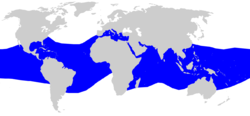Silky shark: Difference between revisions
GrahamBould (talk | contribs) Undid revision 168362392 by 72.17.187.182 (talk) |
|||
| Line 38: | Line 38: | ||
[[Image:Silky_shark.JPG|thumb|200px|Silky shark.]]The silky shark is more active, yet less aggressive than the other two big pelagic sharks, the [[blue shark]] and [[oceanic whitetip]]. It may be more common close to shore than the blue and oceanic whitetip sharks, but it is still a pelagic shark, and quite rarely seen close to shore. The silky shark will most likely be found on reefs which have deep dropoffs. |
[[Image:Silky_shark.JPG|thumb|200px|Silky shark.]]The silky shark is more active, yet less aggressive than the other two big pelagic sharks, the [[blue shark]] and [[oceanic whitetip]]. It may be more common close to shore than the blue and oceanic whitetip sharks, but it is still a pelagic shark, and quite rarely seen close to shore. The silky shark will most likely be found on reefs which have deep dropoffs. |
||
Silky sharks are not generally dangerous to divers, but in the presence of speared fish or if approached directly they can become aggressive, and therefore should be considered a potentially dangerous shark |
Silky sharks are not generally dangerous to divers, but in the presence of speared fish or if approached directly they can become aggressive, and therefore should be considered a potentially dangerous shark. |
||
== Reproduction == |
== Reproduction == |
||
Revision as of 19:58, 31 October 2007
| Silky shark | |
|---|---|

| |
| Scientific classification | |
| Kingdom: | |
| Phylum: | |
| Class: | |
| Subclass: | |
| Order: | |
| Family: | |
| Genus: | |
| Species: | C. falciformis
|
| Binomial name | |
| Carcharhinus falciformis | |

| |
| Range of silky shark | |
Template:Sharksportal The silky shark, Carcharhinus falciformis, is a large pelagic shark of tropical and warm temperate seas.
Distribution
This species is found worldwide in tropical and warm temperate (> 23 °C) seas. It is usually pelagic, but sometimes approaches the coast, especially at remote offshore islands. It is found to depths of at least 500 m.
Appearance

This shark has a large 'typical' shark body, slender with 'silky' smooth skin. It is brown-grey dorsally and white below with no special markings. It can be distinguished from other sharks by the second dorsal fin, which has a very long free tip at the rear, about two and a half times the fin height. The first dorsal fin is also farther back than on any other carcharhiniform, beginning behind the pectoral fins.[1]
The maximum size is 3.3 m, but the length is usually not more than 2.4 m.
Diet
The silky shark is a predator. It feeds mainly on inshore and pelagic bony fishes, but also eats squid and pelagic crab.
Behaviour

The silky shark is more active, yet less aggressive than the other two big pelagic sharks, the blue shark and oceanic whitetip. It may be more common close to shore than the blue and oceanic whitetip sharks, but it is still a pelagic shark, and quite rarely seen close to shore. The silky shark will most likely be found on reefs which have deep dropoffs.
Silky sharks are not generally dangerous to divers, but in the presence of speared fish or if approached directly they can become aggressive, and therefore should be considered a potentially dangerous shark.
Reproduction

These sharks are viviparous (young fed in utero by a placental sac), with a litter size varying from 2 to 14. They are approximately 80 cm long at birth.[1] Sexual maturity is reached near a length of about 2.2 m for females and 2.0 m for males.
Notes
kkk
References
- Template:IUCN2006 Database entry includes justification for why this species is of least concern
- "Carcharhinus falciformis". Integrated Taxonomic Information System. 23 January.
{{cite web}}: Check date values in:|date=and|year=/|date=mismatch (help) - Castro, Jose I. 1996. The Sharks of North American Waters. Texas A&M University Press: College Station, pg 132.

